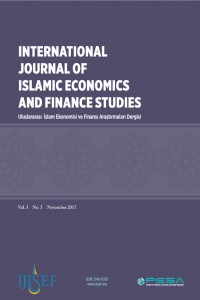Measuring the Waste-Conscious and Saving Habits of the Youth in Turkey: The Sample of Istanbul Medipol University
Öz
Savings are an important source of economic growth. Lack of savings directs country economies to foreign sources. This also increases the debt of the country. Therefore, savings have a critically important for the country's economy. Formation of the saving is associated with culture. The attainment of this culture is a phenomenon that can occur at younger ages. In this study, it was tried to measure the saving habits and waste- conscious of young people in Turkey. A survey study on 503 students was examined by factor analysis and regression analysis. As a result, the increase in the expenditure trends of young people reduces the savings, and the increase in waste sensitivity increases the savings. In addition, increased use of credit cards reduces savings conscious.
Anahtar Kelimeler
Kaynakça
- Armutlulu, İ. H. (2008). İşletmelerde Uygulamalı İstatistik. İstanbul: Alfa Basım Yayım Dağıtım Ltd. Şti. Barış, S., & Uzay, N. (2015, Temmuz-Aralık 1). YURTİÇİ TASARRUFLAR VE EKONOMİK BÜYÜME ARASINDAKİ İLİŞKİ:TÜRKİYE ÖRNEĞİ. Temmuz 10, 2017 tarihinde http://iibf.erciyes.edu.tr/dergi/sayi46/ERUJFEAS_Jul2015_119-151.pdf adresinden alındı Bülbül, H., & Demirer, Ö. (2008). Hizmet Kalitesi Ölçüm Modelleri Servqual ve Serperf'in Karşılaştırmalı Analizi. Selçuk Üniversitesi Sosyal Bilimler Enstitüsü Dergisi, s. 181-192. Dolphin, T. (2012). Young People and Savings: A Route To Improved Financial Resilience. London: Institute for Public Policy Research. Ersin, İ., & Duran, S. (2017). Faizsiz Finans Döngüsünü Oluşturma Açısından Adil Ekonomik Düzen Söyleminin Kredileşme İlkeleri Ve Uygulanabilirliğinin Değerlendirilmesi. Turkish Studies, 12(8), 109-132. Ersin, İ., & Yıldırım, C. (2015). İslam Ekonomisi Çerçevesinde Necmettin Erbakan'ın Adil Ekonomik Düzen Söylemi. AİBÜ Sosyal Bilimler Enstitü Dergisi, s. 143-173. Eti, S., & İnel, M. (2016). A Research on Comparison of Regression Models Explaining the Profitability Base on Financial Data. The International Journal of Business &Management, 4(10), 470-475. Furnham, A. (1999). The Saving and Spending Habits of Young People. Journal Of Ekonomic Psychology, 677-697. Guin, B. (2017, March 1). Culture and Household Saving. Working Paper Series. Frankfurt, Frankfurt, Germany. Hair, J. F., Hult, T. G., Ringle, C. M., & Sarstedt, M. (2014). A Primer on Partial Least Squares Structural Equation Modeling (PLS-SEM). United States of America: SAGE. Hayes, A. F. (2013). Introduction to Mediation, Moderation, and Conditional Process Analysis. New York: The Guilford Press. Karataş, M., & Gavcar, E. (2001). Bazı Meslek Gruplarının Tasarruf Eğilimlerinin Araştırılması:Muğla İli Örneği. Dokuz Eylül Üniversitesi Sosyal Bilimler Enstitüsü Dergisi , 3(2), 38-46. Kim, H.-Y. (2013, Şubat 26). Statistical Notes For Clinical Researchers: Assessing Normal Distribution (2) Using Skewness And Kurtosis. The Korean Academy of Conservative Dentistry, s. 52-54. Mardia, K. (1974). Applications Of Some Measures Of Multivariate Skewness And Kurtosis In Testing Normality And Robustness Studies. The Indian Journal of Statistics, s. 115-128. Sugözü, İ. H. (2017). İslam Ekonomisi ve Adil Ekonomik Düzen. Turkish Studies, 12(8), 185-210. Terzi, H. (2016). Müslüman Tüketicilerin İsraf Davranışlarının Rasyonel Tüketim Ve Gösterişçi Tüketim Bağlamında İncelenmesi: Kültürlerarası Bir Karşılaştırma. Sakarya Üniversitesi Sosyal Bilimler Enstitüsü, 1. Tükel, İ. (2014, Kasım 24). Tüketimin Yeni Aktörleri:"Y" Kuşağı. Hacettepe Üniversitesi Sosyolojik Araştırmalar E-Dergi, s. 1-22. Yeniaras, V. (2015). İslami Dindarlık, Tutumluluk ve Materyalizm:Bir Yapısal Eşitlik Modeli. JEBPIR, 1(1), 49-62. Yuksel, S., & Zengin, S. (2016). Identifying the Determinants of Interest Rate Risk of the Banks: A Case of Turkish Banking Sector. International Journal of Research in Business and Social Science (2147-4478), 5(6), 12-28.
Öz
Kaynakça
- Armutlulu, İ. H. (2008). İşletmelerde Uygulamalı İstatistik. İstanbul: Alfa Basım Yayım Dağıtım Ltd. Şti. Barış, S., & Uzay, N. (2015, Temmuz-Aralık 1). YURTİÇİ TASARRUFLAR VE EKONOMİK BÜYÜME ARASINDAKİ İLİŞKİ:TÜRKİYE ÖRNEĞİ. Temmuz 10, 2017 tarihinde http://iibf.erciyes.edu.tr/dergi/sayi46/ERUJFEAS_Jul2015_119-151.pdf adresinden alındı Bülbül, H., & Demirer, Ö. (2008). Hizmet Kalitesi Ölçüm Modelleri Servqual ve Serperf'in Karşılaştırmalı Analizi. Selçuk Üniversitesi Sosyal Bilimler Enstitüsü Dergisi, s. 181-192. Dolphin, T. (2012). Young People and Savings: A Route To Improved Financial Resilience. London: Institute for Public Policy Research. Ersin, İ., & Duran, S. (2017). Faizsiz Finans Döngüsünü Oluşturma Açısından Adil Ekonomik Düzen Söyleminin Kredileşme İlkeleri Ve Uygulanabilirliğinin Değerlendirilmesi. Turkish Studies, 12(8), 109-132. Ersin, İ., & Yıldırım, C. (2015). İslam Ekonomisi Çerçevesinde Necmettin Erbakan'ın Adil Ekonomik Düzen Söylemi. AİBÜ Sosyal Bilimler Enstitü Dergisi, s. 143-173. Eti, S., & İnel, M. (2016). A Research on Comparison of Regression Models Explaining the Profitability Base on Financial Data. The International Journal of Business &Management, 4(10), 470-475. Furnham, A. (1999). The Saving and Spending Habits of Young People. Journal Of Ekonomic Psychology, 677-697. Guin, B. (2017, March 1). Culture and Household Saving. Working Paper Series. Frankfurt, Frankfurt, Germany. Hair, J. F., Hult, T. G., Ringle, C. M., & Sarstedt, M. (2014). A Primer on Partial Least Squares Structural Equation Modeling (PLS-SEM). United States of America: SAGE. Hayes, A. F. (2013). Introduction to Mediation, Moderation, and Conditional Process Analysis. New York: The Guilford Press. Karataş, M., & Gavcar, E. (2001). Bazı Meslek Gruplarının Tasarruf Eğilimlerinin Araştırılması:Muğla İli Örneği. Dokuz Eylül Üniversitesi Sosyal Bilimler Enstitüsü Dergisi , 3(2), 38-46. Kim, H.-Y. (2013, Şubat 26). Statistical Notes For Clinical Researchers: Assessing Normal Distribution (2) Using Skewness And Kurtosis. The Korean Academy of Conservative Dentistry, s. 52-54. Mardia, K. (1974). Applications Of Some Measures Of Multivariate Skewness And Kurtosis In Testing Normality And Robustness Studies. The Indian Journal of Statistics, s. 115-128. Sugözü, İ. H. (2017). İslam Ekonomisi ve Adil Ekonomik Düzen. Turkish Studies, 12(8), 185-210. Terzi, H. (2016). Müslüman Tüketicilerin İsraf Davranışlarının Rasyonel Tüketim Ve Gösterişçi Tüketim Bağlamında İncelenmesi: Kültürlerarası Bir Karşılaştırma. Sakarya Üniversitesi Sosyal Bilimler Enstitüsü, 1. Tükel, İ. (2014, Kasım 24). Tüketimin Yeni Aktörleri:"Y" Kuşağı. Hacettepe Üniversitesi Sosyolojik Araştırmalar E-Dergi, s. 1-22. Yeniaras, V. (2015). İslami Dindarlık, Tutumluluk ve Materyalizm:Bir Yapısal Eşitlik Modeli. JEBPIR, 1(1), 49-62. Yuksel, S., & Zengin, S. (2016). Identifying the Determinants of Interest Rate Risk of the Banks: A Case of Turkish Banking Sector. International Journal of Research in Business and Social Science (2147-4478), 5(6), 12-28.
Ayrıntılar
| Birincil Dil | İngilizce |
|---|---|
| Bölüm | Araştırma Makalesi |
| Yazarlar | |
| Yayımlanma Tarihi | 1 Kasım 2017 |
| Yayımlandığı Sayı | Yıl 2017 Cilt: 3 Sayı: 3 |

